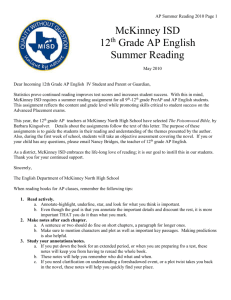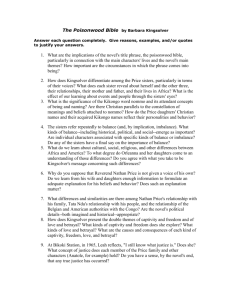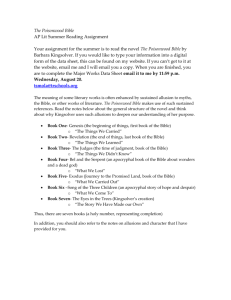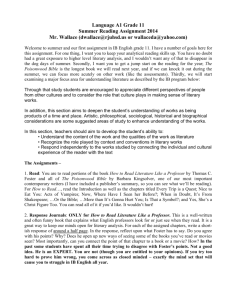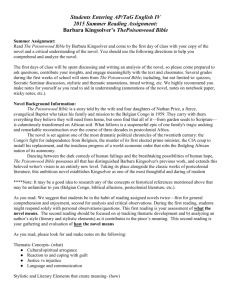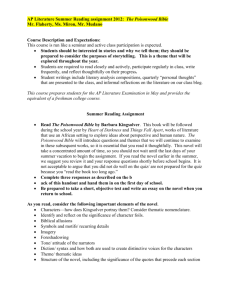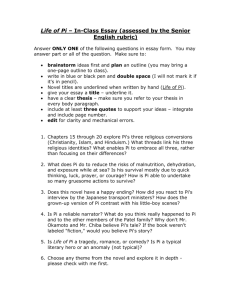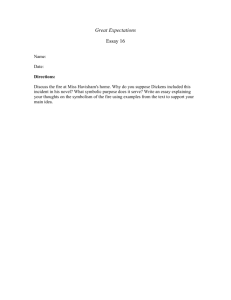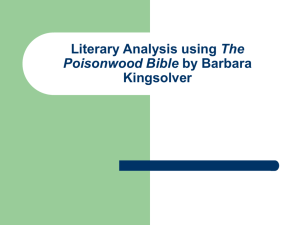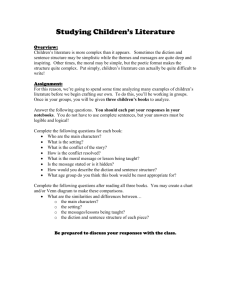The Poisonwood Bible Summer Reading for AP English Literature
advertisement
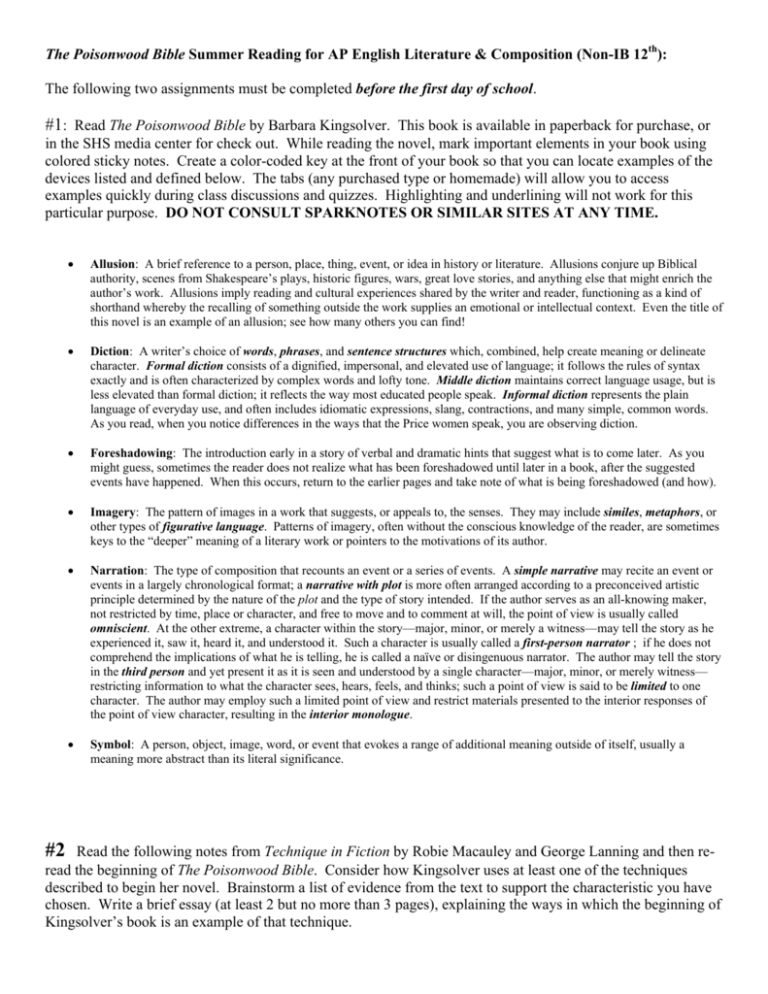
The Poisonwood Bible Summer Reading for AP English Literature & Composition (Non-IB 12th): The following two assignments must be completed before the first day of school. #1: Read The Poisonwood Bible by Barbara Kingsolver. This book is available in paperback for purchase, or in the SHS media center for check out. While reading the novel, mark important elements in your book using colored sticky notes. Create a color-coded key at the front of your book so that you can locate examples of the devices listed and defined below. The tabs (any purchased type or homemade) will allow you to access examples quickly during class discussions and quizzes. Highlighting and underlining will not work for this particular purpose. DO NOT CONSULT SPARKNOTES OR SIMILAR SITES AT ANY TIME. #2 Allusion: A brief reference to a person, place, thing, event, or idea in history or literature. Allusions conjure up Biblical authority, scenes from Shakespeare’s plays, historic figures, wars, great love stories, and anything else that might enrich the author’s work. Allusions imply reading and cultural experiences shared by the writer and reader, functioning as a kind of shorthand whereby the recalling of something outside the work supplies an emotional or intellectual context. Even the title of this novel is an example of an allusion; see how many others you can find! Diction: A writer’s choice of words, phrases, and sentence structures which, combined, help create meaning or delineate character. Formal diction consists of a dignified, impersonal, and elevated use of language; it follows the rules of syntax exactly and is often characterized by complex words and lofty tone. Middle diction maintains correct language usage, but is less elevated than formal diction; it reflects the way most educated people speak. Informal diction represents the plain language of everyday use, and often includes idiomatic expressions, slang, contractions, and many simple, common words. As you read, when you notice differences in the ways that the Price women speak, you are observing diction. Foreshadowing: The introduction early in a story of verbal and dramatic hints that suggest what is to come later. As you might guess, sometimes the reader does not realize what has been foreshadowed until later in a book, after the suggested events have happened. When this occurs, return to the earlier pages and take note of what is being foreshadowed (and how). Imagery: The pattern of images in a work that suggests, or appeals to, the senses. They may include similes, metaphors, or other types of figurative language. Patterns of imagery, often without the conscious knowledge of the reader, are sometimes keys to the “deeper” meaning of a literary work or pointers to the motivations of its author. Narration: The type of composition that recounts an event or a series of events. A simple narrative may recite an event or events in a largely chronological format; a narrative with plot is more often arranged according to a preconceived artistic principle determined by the nature of the plot and the type of story intended. If the author serves as an all-knowing maker, not restricted by time, place or character, and free to move and to comment at will, the point of view is usually called omniscient. At the other extreme, a character within the story—major, minor, or merely a witness—may tell the story as he experienced it, saw it, heard it, and understood it. Such a character is usually called a first-person narrator ; if he does not comprehend the implications of what he is telling, he is called a naïve or disingenuous narrator. The author may tell the story in the third person and yet present it as it is seen and understood by a single character—major, minor, or merely witness— restricting information to what the character sees, hears, feels, and thinks; such a point of view is said to be limited to one character. The author may employ such a limited point of view and restrict materials presented to the interior responses of the point of view character, resulting in the interior monologue. Symbol: A person, object, image, word, or event that evokes a range of additional meaning outside of itself, usually a meaning more abstract than its literal significance. Read the following notes from Technique in Fiction by Robie Macauley and George Lanning and then reread the beginning of The Poisonwood Bible. Consider how Kingsolver uses at least one of the techniques described to begin her novel. Brainstorm a list of evidence from the text to support the characteristic you have chosen. Write a brief essay (at least 2 but no more than 3 pages), explaining the ways in which the beginning of Kingsolver’s book is an example of that technique. Choose a “salient moment” in the life of the story at which to begin. o A “salient moment” is defined as a significant or prominent moment in the storyline or a character’s life. Consider why Orleanna chooses this time of the story from which to narrate. What has she learned? Capture the tone or style of feeling that will echo throughout. o Consider how Kingsolver’s use of figurative language and allusion resonates throughout the novel. Give specific examples of stylistic devices from both the beginning of the novel and the work as a whole. See the story “from the perspective of the ending.” o Reconsider the opening scene after finishing the novel. What new perspective is gained? How does Kingsolver foreshadow future events? What symbols are introduced which become important later? Be sure to use standard formal English and avoid the use of first person (I, me, my) and the second person (you, your). Formal writing should be used for this assignment and all class essays. Format: MLA Heading on page one, at left margin: Your Name AP English Literature August 11, 2014 Write a title, double-spaced under the heading and centered. (Be creative; use something from your main idea. Do not title your paper The Poisonwood Bible or a generic name of the assignment, such as “Essay on Poisonwood”). Times New Roman 12 1 inch margins all around (Use page setup to change the default) All double-spaced, including the heading Your essay should be AT LEAST two pages but should NOT exceed three. Add a header on the top right-hand side with your last name. Add page numbering in the header. Please do not become unduly stressed about this first paper. We certainly want you to do your best work, but we do not want you to be terrified to begin or to turn it in. Remember, we will have the whole year together. If you have any questions over the summer, feel free to e-mail Mrs. Cooper at jane_cooper@scps.k12.fl.us. Your paper will be uploaded to Turnitin.com immediately upon your return to school, so save your essay on your computer. A “hard copy” of your essay will be collected on the first day of school.
